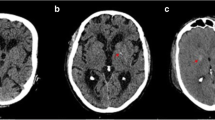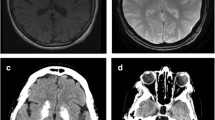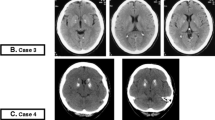Summary
Patients investigated at our institute during the last decade included 166 (1.2%) who showed uni- orbilateral basal ganglia calcification on computed tomography. We tested the significance of this neuroradiological observation by statistical comparison of these patients' clinical disorders with the findings in a random sample of 622 patients without basal ganglia calcification. The odds for the most common neurological disturbances were similar in patients with and without basal ganglia calcification. After adjustment for differences in age and brain atrophy there was no evidence of a significantly increased risk of dementia (odds ratio 1.1), cerebral infarction (1.4), epilepsy (0.9), vertigo (1.6), headache (1.8), or alcoholism (0.9), which represented the most common diagnoses. We conclude that basal ganglia calcification cannot be considered as a clinically relevant neuroradiological finding in the majority of cases and that it should not be used as an explanation for frequently observed neurological disturbances.
Similar content being viewed by others
References
Bollinger G, Herrmann A, Möntmann V (1983) BMDP-Statistikprogramme für die Bio-, Human- und Sozialwissenschaften. Fischer, Stuttgart New York
Ellie E, Julien J, Ferrer X, Riss I, Durquety MC (1989) Extensive cerebral calcification and retinal changes in pseudohypoparathyroidism. J Neurol 236:432–434
Fahr T (1930) Idiopathische Verkalkung der Hirngefässe. Centralbl Allg Pathol Pathol Anat 50:129–133
Fienberg SE (1980) The analysis of cross-classified categorical data. MIT Press, Cambridge, Mass
Förstl H, Eden S, Krumm B, Kohlmeyer K (1990) Psychotic symptoms in basal ganglia sclerosis (Letter). Lancet I:55
Förstl H, Krumm B, Eden S, Kohlmeyer K (1991) What is the psychiatric significance of bilateral basal ganglia mineralization? Biol Psychiatry 29:827–833
Francis AF, Freeman H (1984) Psychiatric abnormality and brain calcification over four generations. J Nerv Ment Dis 172:166–170
Goldscheider HG, Lischewski R, Claus D, Streibl W, Waiblinger G (1980) Klinische, endokrinologische und computertomographische Untersuchungen zur symmetrischen Stammganglienverkalkung. Arch Psychiatr Nervenkr 228:53–65
Harrington MG, MacPherson P, McIntosh WB, Allam BF, Bone I (1981) The significance of the incidental finding of basal ganglia calcification on computed tomography. J Neurol Neurosurg Psychiatry 44:1168–1170
Kazis AD (1985) Contribution of CT scan to the diagnosis of Fahr's syndrome. Acta Neurol Scand 71:206–211
Koller WC, Cochran JW, Klawans HL (1979) Calcification of the basal ganglia: computerized tomography and clinical correlation. Neurology 29:328–333
Löwenthal A, Bruyn GW (1968) Calcification of the striopallidodentate system. In: Bruyn GW, Vinken P (eds) Handbook of clinical neurology, vol 6. North-Holland, Amsterdam, pp 703–729
Morgante L, Vita G, Meduri M, Di Rosa AE, Galatioto S, Coraci MA, Di Perri R (1986) Fahr's syndrome: local inflammatory factors in the pathogenesis of calcification. J Neurol 233:19–22
Ostertag B (1929) Die an bestimmte Lokalisation gebundenen Konkremente des Zentralnervensystems und ihre Beziehung zur „Verkalkung intrazerebraler Gefässe” bei gewissen endokrinen Erkrankungen. Virchows Arch 275:828–859
Puvanendran K, Low CH, Boey HK, Tan KP (1982) Basal ganglia calcification on computer tomographic scan: a clinical and radiological correlation. Acta Neurol Scand 66:309–315
SAS Institute (1985) User's guide statistics, version 5. SAS Institute, Cary, NC
Taxer F, Haller R, König P (1986) Klinische Frühsymptome und CT-Befunde beim Fahr'schen Syndrom. Nervenarzt 57:583–588
World Health Organization (1977) Manual of the international classification of diseases. Injuries and causes of death. WHO, Geneva
Author information
Authors and Affiliations
Rights and permissions
About this article
Cite this article
Förstl, H., Krumm, B., Eden, S. et al. Neurological disorders in 166 patients with basal ganglia calcification: a statistical evaluation. J Neurol 239, 36–38 (1992). https://doi.org/10.1007/BF00839209
Received:
Revised:
Accepted:
Issue Date:
DOI: https://doi.org/10.1007/BF00839209




